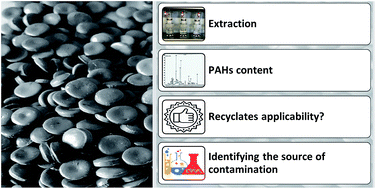The degree and source of plastic recyclates contamination with polycyclic aromatic hydrocarbons
Abstract
In this research, the degree and source of recyclates contamination with polycyclic aromatic hydrocarbons (PAH) was studied in eight different polyolefin recyclate samples; four originating from post-consumer packaging waste and four originating from a mixed source (post-industrial, post-commercial, and post-consumer). The aim was to assess the applicability of these recyclates in the different products' categories. Furthermore, the impact of previous contamination with PAH was excluded by analysing pure plastics before and after undergoing simulated recycling processes. Polythene recyclates originating from post-consumer plastic packaging waste had lower concentrations of the 16-US-EPA PAH (922.15 ± 420.75 μg kg−1) in comparison to the ones of a mixed origin (2155.43 ± 991.85 μg kg−1), r = −0.35, p > 0.05. The degree of recyclates contamination with PAH was always within the REACH limits for consumer products (<1.0 mg kg−1). On the other hand, only polythene recyclate sample originating from post-commercial waste did not comply with the REACH limits for children articles (0.5 mg kg−1). Hence, the source of plastic waste defines the quality of recyclates. All in all, the results indicated that the contamination of polyolefin recyclates with PAH is attributed to the material's previous contamination, or the sorption of plastics to organic compounds from the surrounding environment. Exposing plastics containing PAH additives to heat during extrusion could result in further accumulation of PAH in plastics.



 Please wait while we load your content...
Please wait while we load your content...